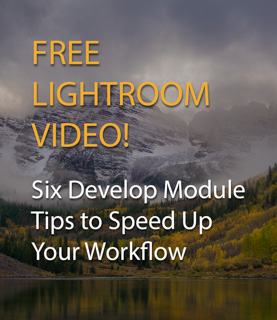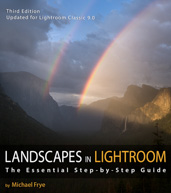by Michael Frye | Jan 6, 2025 | Announcements
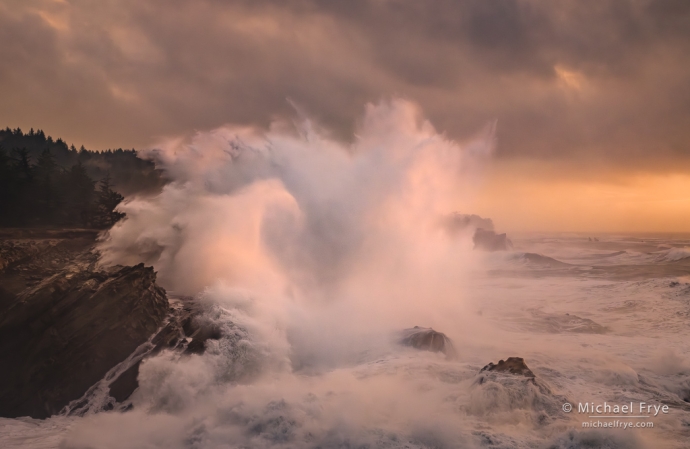
Wave splash at sunset, Oregon Coast
Using Lightroom’s Local Adjustments to Create Powerful Visual Stories
“Dodging and burning are steps to take care of mistakes God made in establishing tonal relationships!”
— Ansel Adams
Successful photographs use light and composition to draw the viewer’s eye to the right spots – the places the photographer wants people to notice. But, as Ansel Adams points out, sometimes nature needs a little help!
When processing images, I probably spend 90% of my time on local adjustments. That includes dodging and burning (lightening and darkening), but also many other subtle and not-so-subtle changes to the luminance, color, and contrast in particular parts of the photograph.
(more…)
by Michael Frye | Jan 5, 2025 | Announcements
The votes are all in and counted, and here are my top photographs of 2024!
We had a great response this year: 627 people looked through my initial selection of 45 images and voted for their favorites. A big thank you to everyone who took the time to look through these photographs and voice your opinions! I also really appreciate the kind words so many people posted in the comments or sent by email. I wish I could respond to everyone, but please know that I’ve read them all and am very grateful for all your support.
(more…)
by Michael Frye | Dec 31, 2024 | Announcements
Happy New Year! Once again I’m inviting you, my faithful blog readers, to help me choose my best photographs from the past year. I’ve posted 45 of my favorite images from 2024 below, in chronological order. After you look through these, please use the form at the bottom of this post to list your ten favorites.
The voting deadline is midnight Pacific Time this Saturday, January 4th. Voting has closed.
You don’t have to list your ten favorites in any order; just pick up to ten images. Once the votes are in I’ll post the top ten or twelve on this blog. (The number for each photo is in the caption underneath the photograph. Also, you can click on the images to see them larger.)
As always, I reserve the right to override the votes if one of my favorites gets panned. But I’ve rarely had to exercise this power because my readers have excellent taste. 🙂
Thanks for your input — I appreciate your help!
(more…)
by Michael Frye | Dec 29, 2024 | Light and Weather
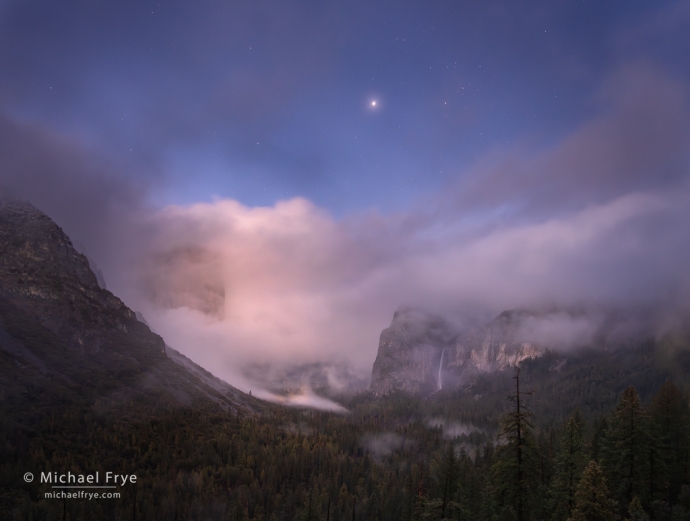
Yosemite Valley at dusk with stars and Jupiter, Yosemite NP, California. This storm cleared just after sunset. It was dark enough for stars to appear, but with a post-sunset glow still lingering on El Capitan. 25mm, 10 seconds at f/4, ISO 2000.
We’ve stayed close to home this month, but I’ve been making lots of photographs. I previously posted photos of fog in the foothills, and ice in Yosemite. But I’ve also been able to photograph Yosemite with clearing storms, and mist, and a moonrise, and with just ordinary, beautiful winter light.
Yosemite Valley is small – only seven square miles. This tiny area is renowned for its grand scenery, but it also contains a wonderful variety of beautiful details and intimate landscapes. No matter how many times I go back, I always find new things to photograph – or find that the same spots look new, and different, under different conditions. There’s always something to photograph there, if I look.
(more…)
by Michael Frye | Dec 22, 2024 | Light and Weather
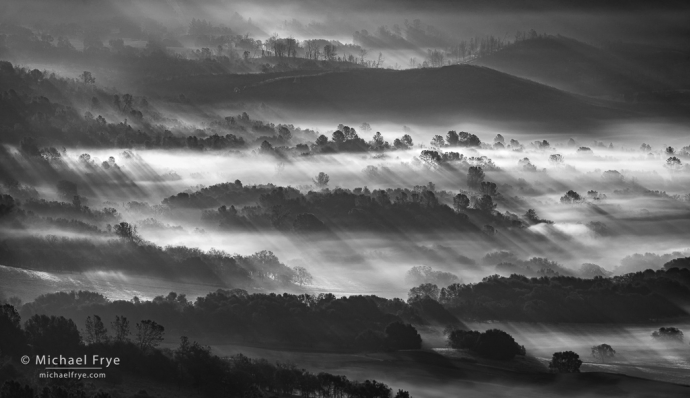
Fog and sunbeams, Sierra Nevada foothills, California. I made this image Wednesday morning, after the sun rose high enough to rake across these layers of fog and trees. In color it was all one note, with everything a pale gold color. Since it was monochromatic anyway, I tried it in black and white, and liked that much better. I think the color distracted from the main story of the photograph, which is about the layers, patterns of light and dark, and tree shadows. 321mm, 1/200 sec. at f/11, ISO 100.
California’s Central Valley is often filled with fog in winter. Usually a shallow layer of fog forms during the night, then burns off the next morning as the sun warms the air. There’s a temporary, low-level inversion during the night and early morning, where the air near the ground is cooler than the air higher up, but when the sun penetrates the fog and warms the ground the inversion ends.
Sometimes, however, the fog in the Central Valley is so thick it doesn’t burn off. The weak sunlight on short winter days never penetrates the fog layer completely, so the fog lasts all day, and into the next night. If the fog persists for a couple of days the inversion will grow deeper (it can get up to two- or three-thousand feet deep), and the fog will gradually lift off the ground into a low overcast, or stratus deck. And then that higher-altitude fog layer will push up into the Sierra foothills. A stratus deck like this can last for several days, or even a week, until a disturbance in the atmosphere (like a storm, or even a weak, dry front) mixes the air and ends the inversion.
(more…)




